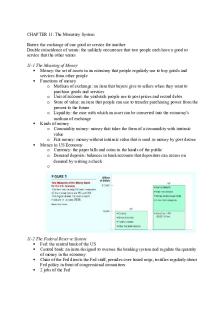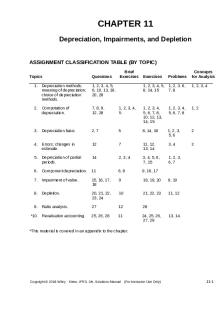Ch 11 - Ch11 PDF

| Title | Ch 11 - Ch11 |
|---|---|
| Author | So wa |
| Course | Macroeconomics I |
| Institution | University of Notre Dame |
| Pages | 2 |
| File Size | 143.9 KB |
| File Type | |
| Total Downloads | 35 |
| Total Views | 199 |
Summary
Ch11...
Description
CHAPTER 11: The Monetary System Barter: the exchange of one good or service for another Double coincidence of wants: the unlikely occurrence that two people each have a good or service that the other wants 11-1 The Meaning of Money Money: the set of assets in an economy that people regularly use to buy goods and services from other people Functions of money o Medium of exchange: an item that buyers give to sellers when they want to purchase goods and services o Unit of account: the yardstick people use to post prices and record debts o Store of value: an item that people can use to transfer purchasing power from the present to the future o Liquidity: the ease with which an asset can be converted into the economy’s medium of exchange Kinds of money o Commodity money: money that takes the form of a commodity with intrinsic value o Fiat money: money without intrinsic value that is used as money by govt decree Money in US Economy o Currency: the paper bills and coins in the hands of the public o Demand deposits: balances in bank accounts that depositors can access on demand by writing a check o
11-2 The Federal Reserve System Fed: the central bank of the US Central bank: an instn designed to oversee the banking system and regulate the quantity of money in the economy Chair of the Fed directs the Fed staff, presides over board mtgs, testifies regularly about Fed policy in front of congressional committees 2 jobs of the Fed
o regulate banks and ensure the health of the banking system o control the quantity of money that is made available in the economy (money supply) monetary policy: the setting of the money supply by policymakers in the central bank Federal Open Market Committee: discusses the condition of the economy and considers changes in monetary policy Open market operation: the purchase and sale of US govt bonds
11-3 Banks and the Money Supply Reserves: deposits that banks have received but have not loaned out
T- account: If banks hold all deposits in reserve banks do not influence the supply of money Fractional reserve banking: a banking system in which banks hold only a fraction of deposits as reserves Reserve ratio: the fraction of deposits that banks hold as reserves When banks hold only a fraction of deposits in reserve, the banking system creates money Money multiplier: the amount of money the banking system generates with each dollar of reserves, it is the reciprocal of the reserve ratio o The higher the reserve ratio, the less of each deposit banks loan out, and the smaller the money multiplier Bank capital: the resources a bank’s owners have put into the instn Leverage: the use of borrowed money to supplement existing funds for purposes of investment Leverage ratio: the ratio of assets to bank capital Capital requirement: a govt regulation specifying a minimum amount of bank capital
11-4 The Fed’s Tools of Monetary Control Open market operations (above) Fed lending to banks o Discount rate: the interest rate on the loans that the fed makes to banks Reserve requirements: regulations on the minimum amount of reserves that banks must hold against deposits Paying interest on reserves Federal funds rate: the interest rate at which banks make overnight loans to one another...
Similar Free PDFs

Ch 11 - Ch11
- 2 Pages

Ch11 - ch 11 prep questions
- 41 Pages

Ch11 Kieso IFRS4 SM ch.11
- 82 Pages

Ch11 - chapter 11 larson
- 67 Pages

Ch11
- 28 Pages

Ch-11 - Chapter 11
- 11 Pages

BSC160 ch 11 - summary of ch 11
- 7 Pages

Ch11 - Solution manual ch11
- 83 Pages

Ch. 11 - Musical Ensembles
- 1 Pages

Ch 11 - Test bank
- 20 Pages

Ch. 11 Review Sheet
- 4 Pages

Ch 11 Answers
- 18 Pages
Popular Institutions
- Tinajero National High School - Annex
- Politeknik Caltex Riau
- Yokohama City University
- SGT University
- University of Al-Qadisiyah
- Divine Word College of Vigan
- Techniek College Rotterdam
- Universidade de Santiago
- Universiti Teknologi MARA Cawangan Johor Kampus Pasir Gudang
- Poltekkes Kemenkes Yogyakarta
- Baguio City National High School
- Colegio san marcos
- preparatoria uno
- Centro de Bachillerato Tecnológico Industrial y de Servicios No. 107
- Dalian Maritime University
- Quang Trung Secondary School
- Colegio Tecnológico en Informática
- Corporación Regional de Educación Superior
- Grupo CEDVA
- Dar Al Uloom University
- Centro de Estudios Preuniversitarios de la Universidad Nacional de Ingeniería
- 上智大学
- Aakash International School, Nuna Majara
- San Felipe Neri Catholic School
- Kang Chiao International School - New Taipei City
- Misamis Occidental National High School
- Institución Educativa Escuela Normal Juan Ladrilleros
- Kolehiyo ng Pantukan
- Batanes State College
- Instituto Continental
- Sekolah Menengah Kejuruan Kesehatan Kaltara (Tarakan)
- Colegio de La Inmaculada Concepcion - Cebu



